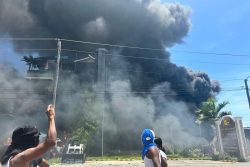Sean Hinds comes out of the dark and dangerous recesses of our recent history. In the relating of events of that era, he cleverly ensures that the confessions that he makes stop short of implicating him in any criminal activity, save that his admission that he was contracted to kill Ronald Waddell may point to involvement in a conspiracy to commit a crime. That admission is a matter for the police.
Sean Hinds emerged against a background of seething political convulsions, which started immediately after the 1992 general elections, subsided, resumed after the 1997 general elections, subsided, then resumed again after the 2001 general elections. Into this sustained cauldron of political unrest directed against the PPP, was injected the criminal terrorism by the Mash Day 2002 jailbreak gang of five dangerous criminals who set up residence in Buxton. They were succeeded by the Fineman gang which killed until 2008.
Georgetown and the lower East Coast lived in terror during the period that these criminals and the gang or gangs that formed around them, perpetrated their wanton killings, robberies, kidnappings, rapes and other depredations in the most heinous manner. Indians and policemen, as separate groups, were the main, though not the only, targets and victims.
 In a series of articles at or around the time that the crime spree ended, under the caption ‘Guyana Under Siege – The Failure of the Buxton Conspiracy,’ Mr Frederick Kissoon detailed what many believe to be a credible analysis of the events and activities surrounding the criminal gang and the political conspiracies that developed around them. The toxic mixture of politics, race and crime, the vain effort by an organized group of activists to politicize what was in effect a criminal enterprise, the struggle for supremacy between crime and politics, the motivations behind the killings and many other issues are explained and analyzed in depth. The series of articles is available online.
In a series of articles at or around the time that the crime spree ended, under the caption ‘Guyana Under Siege – The Failure of the Buxton Conspiracy,’ Mr Frederick Kissoon detailed what many believe to be a credible analysis of the events and activities surrounding the criminal gang and the political conspiracies that developed around them. The toxic mixture of politics, race and crime, the vain effort by an organized group of activists to politicize what was in effect a criminal enterprise, the struggle for supremacy between crime and politics, the motivations behind the killings and many other issues are explained and analyzed in depth. The series of articles is available online.
It is this period of great fear in the country and the marked impotence of the security forces that Sean Hinds and his group emerged, went into action and gained notoriety. As yet unidentified as a ‘death squad,’ but recognized as a separate group, they had the tacit support of Indians who felt themselves naked under the murderous siege of violent criminals and without protection by the security forces. Some knew that any operation planned by the security forces against the criminals was leaked to the latter before the operation took place, so that they were able to evade confrontation or capture. This was an era of full-blown criminal terrorism and warfare, with political underpinnings.
The truth of these events from the perspective of the death squad is available from Sean Hinds and others members of the death squad. With the truth comes justice, but the truth could also confirm to those who felt under siege at the time that the security forces were unable or unwilling to protect them, while the death squad was.
The past and continuing consequences of crime largely, though not exclusively, against Indians and the impact on their general outlook, political, ethnic and otherwise, is hardly ever openly spoken about, except once many years ago, courageously, by Eusi Kwayana. Sean Hinds is seen as a criminal by the government, and is an unlikely hero, but one section of the population may well view him as a saviour in a difficult time. APNU+AFC’s long-term viability depends much on if it is able to grapple with, and treat with sensitivity, this dichotomous reality of Guyana.
The pursuit of justice is a matter for professionals with an array of tools. These professionals include police, prosecutors, defence counsel, judges and juries who are required to work without government interference. Hinds did not ask the government for amnesty, but the government has rejected it even before a request is made. The rejection of amnesty in this way constitutes government interference in the process of criminal investigation, in the prosecutorial process and in the pursuit of justice because it sends a message to the concerned agencies which need to work without oppressive messages of this kind.
One of the instruments available in the search for justice is the Criminal Procedure (Plea Bargaining and Plea Agreement) Act which was passed by the National Assembly in 2008. It facilitates the Director of Public Prosecutions to negotiate deals with criminals by agreeing to lighter than normal sentences for information and giving evidence against other criminals. While it is the Director who has technical oversight, it is the police who do the job and in the past the Director has called on the police to make use of the provisions of the Act. Prior to the passing of this legislation, and even after, many criminals have evaded prosecution by the failure of the police to creatively implement plea bargaining. To allow for this to happen and to put more criminals behind bars the government needs to be cautious and not shoot from the hip, or lip, at every opportunity, or news cycle.









